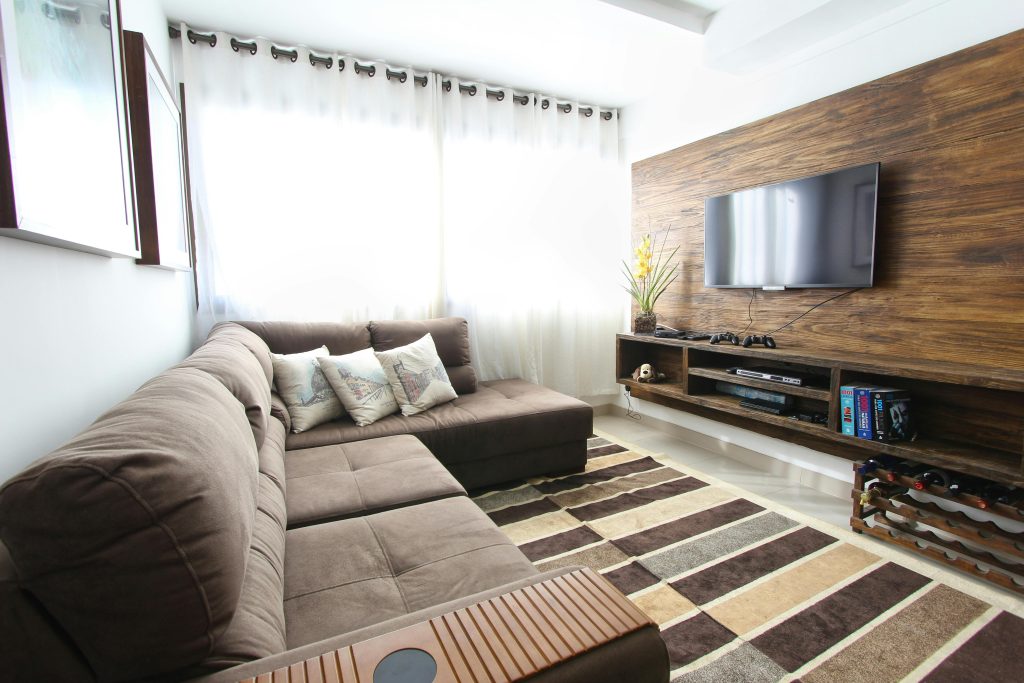It’s more than aesthetics to create a family-friendly home. You need to design a space that is safe, functional, and comfortable for all members of your family. It’s important to consider how your home will support the daily activities of everyone in your household, whether they are young children, teens, or elderly relatives. This article will explore 10 easy ways to make your house more family-friendly, from practical storage to a clean, safe environment. With a few thoughtful modifications, you can create a home that supports and nurtures your family.
1. Smart Storage Solutions Maximise Space

Maximising space is a cornerstone of a family-friendly home, where accessibility and organisation are key. Smart storage solutions allow every family member to easily find what they need while reducing the clutter that can overwhelm living spaces. Vertical storage options, such as wall-mounted shelves, hooks, and racks, are excellent for utilising otherwise underused wall space. These solutions are particularly effective in smaller homes or apartments, helping to keep everyday essentials within reach without sacrificing valuable floor area. Multi-purpose furniture, such as ottomans with hidden compartments or beds with built-in drawers, can also serve double duty by offering both utility and aesthetic appeal. Incorporating custom shelving or built-in cabinetry tailored to your family’s needs is another way to create streamlined storage and eliminate disorganisation.
In addition to traditional solutions, considering innovative approaches like under-sink shelving or modernised plumbing layouts can further maximise small spaces, particularly in bathrooms or kitchens. These adjustments can be especially beneficial in older homes, where storage areas may be limited. Encouraging your family to adopt habits like labelling storage bins and categorising items ensures that the home remains tidy and efficient over time. Smart storage not only simplifies daily routines but also fosters a sense of calm and order, creating an environment where the entire family can thrive.
2. Create Kid-Friendly Zones at Home
Designating specific areas for children within your home can help maintain order while giving them a sense of ownership and independence. Kid-friendly zones, such as dedicated play areas, study stations, or quiet reading corners, provide spaces tailored to their needs and activities. Incorporate furniture crafted from sturdy materials with rounded edges to prioritise safety without sacrificing functionality. Storage solutions like colourful shelving units, labelled bins, or drawers can keep toys, books, and school supplies neatly organised, making it easier for children to find and return items. This not only fosters organisation but also instils a sense of responsibility and pride in maintaining their spaces.
Maintaining a comfortable environment in these zones is equally important, and regular HVAC servicing plays a key role. Whether it’s a hot summer day or a chilly winter evening, a well-maintained HVAC system ensures consistent and pleasant temperatures throughout the year. These climate-controlled spaces allow children to focus on their activities without discomfort or distraction. Thoughtfully designed kid-friendly areas promote creativity, learning, and relaxation, all while contributing to a harmonious and well-regulated home environment.
3. Invest in Comfortable, Durable Furniture

Creating a family-friendly home starts with choosing furniture that is both durable and comfortable. With the daily demands of children, pets, and busy lifestyles, robust furniture is essential to withstand wear and tear while maintaining its aesthetic appeal. Materials like leather, microfiber, and stain-resistant fabrics are ideal for their ease of cleaning and resistance to spills, scratches, and general messes. Investing in sturdy sofas, reclining chairs, and solid dining tables ensures your furniture can handle everything from family meals to playtime. Prioritising furniture with rounded edges and soft finishes can also enhance safety, particularly for families with young children.
In addition to furniture, flooring plays a significant role in creating a functional living space. Tile floors, for example, are an excellent choice as they are durable, low-maintenance, and resistant to heavy foot traffic. They pair well with a variety of furniture styles and can handle the rigours of an active household. Layering rugs on tile floors can add warmth and comfort while offering an extra layer of protection for high-use areas. By choosing furniture and flooring that balance practicality with style, you can create a home that is both inviting and resilient, making everyday life easier and more enjoyable for the whole family.
4. Home Maintenance That Is Safe and Effective
Maintaining a safe and efficient home is vital for fostering a healthy and comfortable environment for your family. Proactive upkeep of essential systems such as plumbing, electrical, and HVAC ensures your home operates smoothly and reduces the likelihood of costly repairs. Regular inspections of these systems are key to identifying potential issues early. For instance, scheduling furnace checks and air conditioning servicing helps maintain a comfortable indoor climate year-round, while reducing energy inefficiencies. Ensuring that appliances and electrical systems are in good condition can also minimise safety risks, such as fire hazards or power outages.
Beyond the core systems, addressing areas prone to moisture, such as bathrooms and basements, is equally important. Dampness can lead to mould and mildew, which pose health risks, particularly for individuals with allergies or respiratory conditions. Conduct regular checks for signs of growth and promptly hire professional mould removal services if needed. Routine cleaning, including thorough dusting and vacuuming, further contributes to a safer living space by reducing allergens. By prioritising regular maintenance, you not only extend the life of your home but also create a space that is safe, functional, and comfortable for your family.
5. Add Outdoor Living Spaces to Enjoy with Family
Outdoor living spaces offer endless opportunities for relaxation, family bonding, and entertaining. By creating a dedicated area outside, you extend your home’s functionality and encourage your family to spend more time in the fresh air. Adding features like a deck, garden seating, or a covered patio provides versatile spaces for dining, playing, or simply unwinding together. Installing patio covers or pergolas ensures that these spaces are comfortable throughout the year, protecting you from Australia’s blazing summer sun or unexpected rainfall. Selecting weather-resistant furniture made from materials such as wicker, aluminium, or powder-coated steel ensures your outdoor setup is long-lasting and stylish.
To make your outdoor area truly inviting, incorporate cosy touches that enhance comfort and visual appeal. Outdoor rugs, cushions, and throw blankets can soften the space and make it feel like an extension of your home’s interior. Lighting, such as string lights or solar-powered lamps, can add charm and create a warm ambience for evening gatherings. You might also consider integrating greenery with potted plants, vertical gardens, or flower beds to bring natural beauty into the space. A thoughtfully designed outdoor living area not only serves as a retreat but also becomes a focal point for creating cherished family memories.
6. Indoor Air Quality and Clean Air: Ensure Better Indoor Air Quality
Improved indoor air quality is vital for your family’s health. Poor air quality is linked to respiratory problems, allergies, and other health issues, particularly for children and those with sensitive skin. Start by changing HVAC filters regularly and installing air purifiers throughout your home. Open windows when the weather permits and use fewer harsh chemicals to reduce indoor air pollution. Adding houseplants will also help improve air quality as they filter toxins. Regular cleaning of carpets, curtains, and upholstery can reduce dust and allergens. By taking these simple steps, you can create a healthier environment for your family.
7. Plan a Home Renovation to Adapt for Family Life
Home renovations are a practical way to ensure your living space evolves with your family’s changing needs. Whether your family is growing or simply requires a more functional layout, renovations allow you to customise your home to better suit your lifestyle. Adding rooms, such as extra bedrooms or bathrooms, can alleviate space constraints, while creating an open-plan kitchen or living area fosters greater connection during family activities. Renovations also provide an opportunity to enhance accessibility, ensuring your home accommodates family members of all ages and abilities. Thoughtful design and planning can turn your house into a space that grows with your family.
It’s essential to enlist skilled professionals, such as electricians and plumbers, to ensure any upgrades comply with safety standards and meet modern demands. Upgrading your home’s electrical systems is particularly important, as contemporary appliances and devices often require increased power capacity. Beyond comfort, renovations can add significant value to your property, making them a worthwhile investment for the future. By focusing on functionality and family-friendly features, such as durable materials and versatile layouts, you can create a home that not only meets your immediate needs but also supports your family for years to come.
8. Pest Control in the Home: How to Prevent and Manage Pests
Pests in the home can quickly turn a happy family household into one that feels stressful. Managing and preventing pests is essential for maintaining a comfortable living environment. Seal any cracks or gaps around windows, doors, and walls that pests could enter. Store food securely and clean up spills or crumbs that may attract insects. Consider hiring pest control professionals to treat larger infestations. These experts can eliminate pests such as rodents, termites, and ants, ensuring your home remains free from unwanted guests. Regular maintenance and vigilance are key to keeping pests away and protecting your family’s health.
9. Make Your Home More Accessible for Everyone
Designing an accessible home ensures comfort and functionality for all family members, regardless of age or ability. Simple yet effective additions, such as grab bars in bathrooms, handrails on stairs, and lower shelves in frequently used areas, can make everyday tasks more manageable for elderly relatives or young children. Wider doorways and open-plan layouts not only improve mobility but also create a more inclusive and adaptable living space. These thoughtful changes ensure your home accommodates the diverse needs of your family while promoting independence and safety.
Temperature control is another essential aspect of accessibility and comfort. Maintaining a consistent indoor climate, especially during colder months, is vital for creating a welcoming environment for everyone. Ensuring your heating system is well-maintained and reliable through regular servicing can help achieve this, offering warmth and peace of mind. By making these adjustments, you can transform your home into a space that caters to the needs of all family members, fostering a sense of security and belonging.
10. Add Personal Touches to Make Your Home Feel Like a Sanctuary
Creating a home that feels like a sanctuary starts with adding personal touches that reflect your family’s personality and style. Simple yet meaningful details, such as family photographs, cosy blankets, or treasured mementos, can evoke warmth and a sense of belonging. Incorporate décor that highlights your family’s hobbies or interests, whether it’s a feature wall showcasing artwork, a collection of travel souvenirs, or furniture pieces that tell a story. These thoughtful elements turn a house into a home that feels uniquely yours, offering comfort and joy in every corner.
If a renovation is on the cards, consider designing spaces that encourage relaxation and family togetherness. A reading nook with plush cushions, a spacious area for family game nights, or even a spa-inspired bathroom with soft lighting and luxurious finishes can enhance your home’s ambience. These tailored features not only create a sense of peace and comfort but also provide dedicated spaces for your family to unwind and connect. By blending practicality with personalisation, you can craft a home that is a true haven for everyone.
Conclusion
It doesn’t take a huge budget or drastic changes to create a stylish, functional home for your family. Thoughtful planning and upgrades will make a world of difference. By focusing on practical updates, such as improving storage, increasing safety, and creating a healthy home environment, you can significantly enhance your family’s comfort and enjoyment. Simple changes, like creating kid-friendly areas, improving air quality, and establishing outdoor spaces, will make your everyday life more organised and manageable. Each small step, from choosing durable furniture to maintaining essential systems regularly, adds up to an environment that supports your family. Even minor improvements can make a significant impact on how your home feels. With just a few thoughtful upgrades, you can create a family-friendly, welcoming space.
